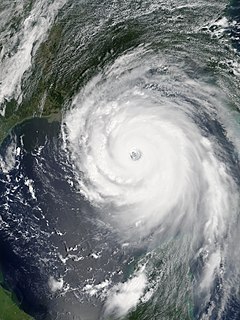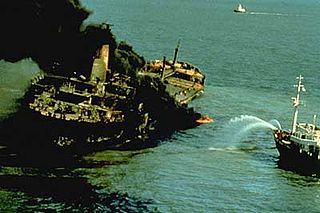
Chalmette is a census-designated place (CDP) in, and the parish seat of, St. Bernard Parish in southeastern Louisiana, United States. The 2010 census reported that Chalmette had 16,751 people; 2011 population was listed as 17,119; however, the pre-Katrina population was 32,069 at the 2000 census. At the 2020 U.S. census, its population rebounded to 21,562. Chalmette is part of the New Orleans–Metairie–Kenner metropolitan statistical area. Chalmette is located east of downtown New Orleans and south of Arabi, towards Lake Borgne.

An environmental disaster or ecological disaster is defined as a catastrophic event regarding the natural environment that is due to human activity. This point distinguishes environmental disasters from other disturbances such as natural disasters and intentional acts of war such as nuclear bombings.
The Chemical Coast is a section of Union and Middlesex counties in New Jersey located along the shores of the Arthur Kill, across from Staten Island, New York. The name is taken from the Conrail Chemical Coast Line, an important component in the ExpressRail system serving marine terminals in the Port of New York and New Jersey.
Oil Storm is a 2005 television simulation portraying a future oil-shortage crisis in the United States, precipitated by a hurricane destroying key parts of the United States' oil infrastructure. The program was an attempt to depict what would happen if the highly oil-dependent country was suddenly faced with gasoline costing upwards of $7 to $8 per gallon. Directed by James Erskine and written by Erskine and Caroline Levy, it originally aired on FX Networks on 5 June 2005, at 8 p.m. ET.

Hurricane Katrina was a destructive Category 5 Atlantic hurricane that caused over 1,800 fatalities and $125 billion in damage in late August 2005, especially in the city of New Orleans and the surrounding areas. It was at the time the costliest tropical cyclone on record and is now tied with 2017's Hurricane Harvey. The storm was the twelfth tropical cyclone, the fifth hurricane, and the third major hurricane of the 2005 Atlantic hurricane season, as well as the fourth-most intense Atlantic hurricane on record to make landfall in the contiguous United States.
The article covers the Hurricane Katrina effects by region, within the United States and Canada. The effects of Hurricane Katrina, in late August 2005, were catastrophic and widespread. It was one of the deadliest natural disasters in U.S. history, leaving at least 1,836 people dead, and a further 135 missing. The storm was large and had an effect on several different areas of North America.
The economic effects of Hurricane Katrina, which hit Louisiana, Florida, Texas and Mississippi in late August 2005, were far-reaching.

Audubon Aquarium of the Americas is an aquarium in New Orleans, Louisiana, United States.

Murphy Oil Corporation is a company engaged in hydrocarbon exploration headquartered in Houston, Texas.

The Murphy Oil USA refinery spill was an oil spill that resulted from the failure of a storage tank at the Murphy Oil USA petroleum refinery in the residential areas of Chalmette and Meraux, Louisiana, United States, on August 30, 2005, the day after Hurricane Katrina made landfall on the U.S. Gulf Coast.
O'Brien's Response Management is the largest oil spill management company in the United States

Greka Energy, legally HVI Cat Canyon Inc., is a privately held company engaged in hydrocarbon exploration principally in Santa Barbara County, California. Formed in 1999 after the acquisition and merger of several smaller firms, it is a subsidiary of Greka Integrated, Inc., a holding company headquartered in Santa Maria, California, and is wholly owned by Randeep Grewal.

The Morris J. Berman oil spill occurred on January 7, 1994, when the Morris J. Berman, a single-hull 302-foot-long barge, with the capacity to carry more than 3 million gallons of oil, collided with a coral reef near San Juan, Puerto Rico, causing the release of 750,000 gallons of heavy grade oil. The spill affected the tourism and fishing industries as well as wildlife along the shores of Puerto Rico, Isla de Culebra, and Isla de Vieques. The spill had major long-lasting impacts on the biological and natural resources of the entire Puerto Rican area. This spill was also the first to occur in U.S. waters after the passing of the Oil Pollution Act of 1990.

The 2010 Port Arthur oil spill was the result of a collision between two vessels in the Sabine-Neches Waterway at Port Arthur, Texas on January 23, 2010. The two vessels were the oil tanker Eagle Otome and a barge being pushed by the towboat Dixie Vengeance.

The M/T Burmah Agate was an oil tanker that was involved in a nautical collision and subsequent oil spill near Galveston, Texas in November 1979. 31 crewmen were killed in the collision, and the oil spill damaged the local environment.
Following is a timeline of the Deepwater Horizon oil spill for June 2010.
Following is a timeline of the Deepwater Horizon oil spill for July 2010.

The Deepwater Horizon oil spill occurred between 10 April and 19 September 2010 in the Gulf of Mexico. A variety of techniques were used to address fundamental strategies for addressing the spilled oil, which were: to contain oil on the surface, dispersal, and removal. While most of the oil drilled off Louisiana is a lighter crude, the leaking oil was of a heavier blend which contained asphalt-like substances. According to Ed Overton, who heads a federal chemical hazard assessment team for oil spills, this type of oil emulsifies well. Once it becomes emulsified, it no longer evaporates as quickly as regular oil, does not rinse off as easily, cannot be broken down by microbes as easily, and does not burn as well. "That type of mixture essentially removes all the best oil clean-up weapons", Overton said.
The 2004 Taylor Energy oil spill is an ongoing spill located in the Gulf of Mexico, around 11 miles (18 km) off the coast of the U.S. state of Louisiana. It is the result of the destruction of a Taylor Energy oil platform during Hurricane Ivan in 2004. It is the longest-running oil spill in U.S. history. It was first brought to public attention when contamination at the site was noticed in 2010 by those monitoring the nearby Deepwater Horizon oil spill. A report by the Associated Press in 2015 challenged the estimates of the extent of the leak originally given by the company and the U.S. Coast Guard (USCG), which were then revised to be around 1,000 times greater than initially reported.